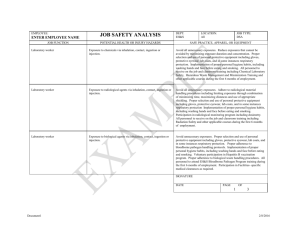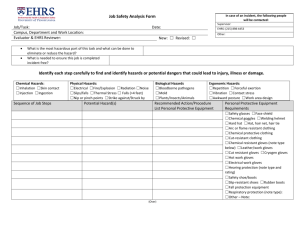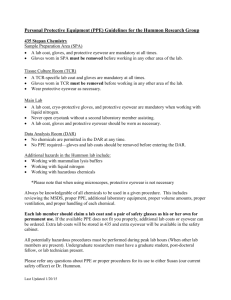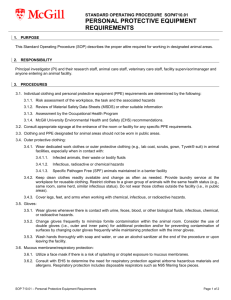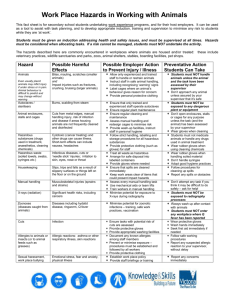JSA Template
advertisement
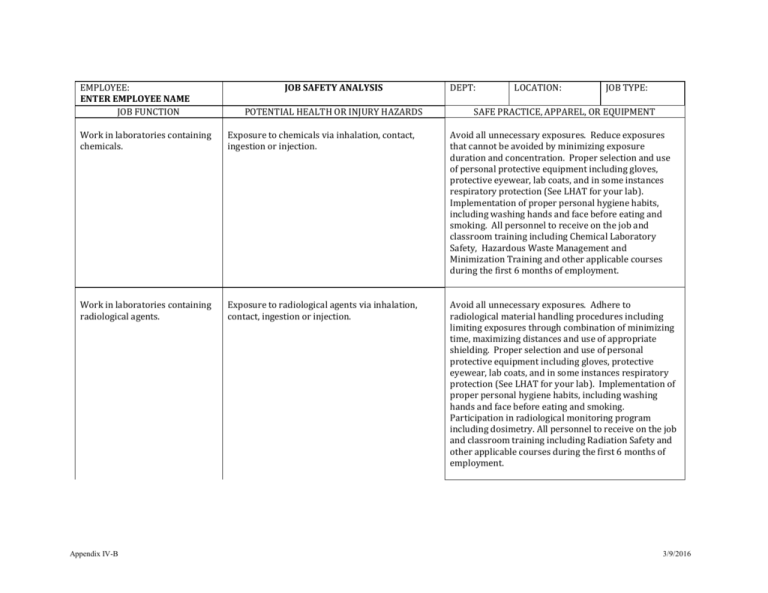
EMPLOYEE: ENTER EMPLOYEE NAME JOB FUNCTION JOB SAFETY ANALYSIS POTENTIAL HEALTH OR INJURY HAZARDS DEPT: LOCATION: JOB TYPE: SAFE PRACTICE, APPAREL, OR EQUIPMENT Work in laboratories containing chemicals. Exposure to chemicals via inhalation, contact, ingestion or injection. Avoid all unnecessary exposures. Reduce exposures that cannot be avoided by minimizing exposure duration and concentration. Proper selection and use of personal protective equipment including gloves, protective eyewear, lab coats, and in some instances respiratory protection (See LHAT for your lab). Implementation of proper personal hygiene habits, including washing hands and face before eating and smoking. All personnel to receive on the job and classroom training including Chemical Laboratory Safety, Hazardous Waste Management and Minimization Training and other applicable courses during the first 6 months of employment. Work in laboratories containing radiological agents. Exposure to radiological agents via inhalation, contact, ingestion or injection. Avoid all unnecessary exposures. Adhere to radiological material handling procedures including limiting exposures through combination of minimizing time, maximizing distances and use of appropriate shielding. Proper selection and use of personal protective equipment including gloves, protective eyewear, lab coats, and in some instances respiratory protection (See LHAT for your lab). Implementation of proper personal hygiene habits, including washing hands and face before eating and smoking. Participation in radiological monitoring program including dosimetry. All personnel to receive on the job and classroom training including Radiation Safety and other applicable courses during the first 6 months of employment. Appendix IV-B 3/9/2016 EMPLOYEE: ENTER EMPLOYEE NAME JOB FUNCTION Work in laboratories containing biological materials. Work with BSL 2 agents Appendix IV-B JOB SAFETY ANALYSIS POTENTIAL HEALTH OR INJURY HAZARDS Exposure to biological agents via inhalation, contact, ingestion or injection. DEPT: LOCATION: JOB TYPE: SAFE PRACTICE, APPAREL, OR EQUIPMENT Avoid unnecessary exposures. Proper selection and use of personal protective equipment including gloves, protective eyewear, lab coats, and in some instances respiratory protection (See LHAT for your lab). Proper adherence to bloodborne pathogen handling protocols. Implementation of proper personal hygiene habits, including washing hands and face before eating and smoking. Voluntary participation in Hepatitis B vaccination program. Proper adherence to biological waste handling procedures. All personnel to attend EH&S Bloodborne Pathogen Program training during the first 6 months of employment. Participation in Facilities- specific medical clearances as required. No eating, drinking, chewing gum, smoking, applying cosmetics etc.. within the laboratory. Implementation of proper hygiene habits before leaving the lab, including removal of lab coats and gloves and washing hands. Proper adherence to biological/medical waste handling procedures and procedures specified in the lab’s Biological Use Authorization (BUA). All personnel to receive on the job and classroom training including “Biological and medical waste management” and “safe use of biological safety cabinet”. Proper selection and use of personal protective equipment including gloves, protective eyewear, lab coats, and in some instances respiratory protection 3/9/2016 EMPLOYEE: ENTER EMPLOYEE NAME JOB FUNCTION Work in laboratory with animals Work in laboratories, shops and spaces containing physical hazards. Appendix IV-B JOB SAFETY ANALYSIS POTENTIAL HEALTH OR INJURY HAZARDS Possible exposure to animals and animal allergies via inhalation and contact Injury from physical hazards including high voltage, lasers and ultraviolet light, compressed gases and liquids, cryogenic materials, and specialized equipment as well as falling objects. DEPT: LOCATION JOB TYPE EH&S All DSA SAFE PRACTICE, APPAREL, OR EQUIPMENT All personnel to attend the IACUC Animal Care and Use 101 training prior to working with animals. Participation in Facilities- specific medical clearances as required. Avoid unnecessary exposures (all animal work done off site at Animal Resource Service). As needed or necessary proper selection and use of personal protective equipment including gloves, protective eyewear, lab coats, and in some instances respiratory protection. Proper adherence to animal care and use protocols. Implementation of proper personal hygiene habits before leaving area, including washing hands. Participation in the occupational health program for animal workers. Avoid unnecessary exposures. Proper selection and use of personal protective equipment including gloves, protective eyewear and specialized euipment. Employees are not to enter restricted areas unless accompanied by a properly trained individual familiar with the hazards of the area. Employees are not to operate specialized equipment without proper training and documentation. Watch for overhead hazards and wear head protection if needed. Personnel auditing or routinely entering areas where lasers are used will receive laser safety training within 6 months of employment. 3/9/2016 EMPLOYEE: ENTER EMPLOYEE NAME JOB FUNCTION JOB SAFETY ANALYSIS POTENTIAL HEALTH OR INJURY HAZARDS DEPT: LOCATION JOB TYPE EH&S All DSA SAFE PRACTICE, APPAREL, OR EQUIPMENT Handling and moving heavy items and equipment. Ergonomic hazards including heavy lifting, repetitive motions, awkward motions, crushing or pinching injuries etc. Get help with all loads that cannot be safely lifted by one person. Use mechanical means to lift and move heavy items, push carts and dolly rather than pull, attend back safety class, employ proper lifting techniques at all times. Set up work operations as ergonomically safe as practical. Wear proper hand and foot protection to protect against crushing or pinching injuries. Operation of Motor vehicles Motor vehicle accidents involving personal injury, or property damage All drivers of UCD vehicles (greater than 10% of your job) should take the online Safe Driver Awareness Course offered by the UC Learning Center and possess a valid California drivers license. Hazardous materials may not be transported in personally owned vehicles. Appendix IV-B 3/9/2016 EMPLOYEE: ENTER EMPLOYEE NAME JOB FUNCTION JOB SAFETY ANALYSIS POTENTIAL HEALTH OR INJURY HAZARDS DEPT: LOCATION: JOB TYPE: SAFE PRACTICE, APPAREL, OR EQUIPMENT General office work. Backstrain, eyestrain, repetitive motion injury. Physical injuries due to slips, trips and falls, and falling objects. Electrical hazards. Physical injuries due to fires, earthquakes, bomb threats and workplace violence. Ensure that workstations are ergonomically correct. Keep floors clear of debris and liquid spills. Keep furniture, boxes, etc. from blocking doorways, halls and walking space. Do not stand on chairs of any kind, use proper foot stools or ladders. Do not store heavy objects overhead. Do not topload filing cabinets, fill bottom to top. Do not open more than one file drawer at a time. Brace tall bookcases and file cabinets to walls. Provide one-inch lip on shelves. Do not use extension cords in lieu of permanent wiring. Ensure that high wattage appliances do not overload cicuits.Use GFIs in receptacles in potentially wet areas. Replace frayed or damaged electrical cords. Ensure that electrical cords are not damaged by being wedged against furniture or pinched in doors. Attend emergency action and fire prevention plan training including emergency escape drills. Attend Workplace Violence training offered by UC Davis Police Department. Work in Sensory Facility Potential injury from physical hazards including high voltage, cuts and burns, slips, trips and falls, and falling objects. Avoid unnecessary exposures. If necessary and needed proper selection and use of personal protective equipment including gloves, protective eyewear and other specialized euipment. Keep floors clear of debris and liquid spills. Do not stand on chairs of any kind, use proper foot stools or ladders. Do not store heavy objects overhead Must follow safe food practices, keep perishables refrigerated, and must alert tasters of possible food alergens. Have prior approvals for studies with human subjects as required by UC Davis. Potential food poisoning, allergies. Appendix IV-B 3/9/2016 EMPLOYEE: ENTER EMPLOYEE NAME JOB FUNCTION Field work JOB SAFETY ANALYSIS POTENTIAL HEALTH OR INJURY HAZARDS Travel hazards Exposure to biological agents via inhalation, contact, ingestion or injection. Heat exhaustion DEPT: LOCATION JOB TYPE EH&S All DSA SAFE PRACTICE, APPAREL, OR EQUIPMENT Prior to leaving on field trip, should read and sign department field trip guidelines and warnings. Avoid unnecessary exposures. Proper selection and use of personal protective equipment including gloves, protective eyewear, lab coats, and in some instances respiratory protection. Implementation of proper personal hygiene habits, including washing hands and face before eating and smoking. Proper adherence to biological waste handling procedures. Where applicable, proper adherence to bloodborne pathogen handling protocols and attend EH&S Bloodborne Pathogen Program training during the first 6 months of employment. Voluntary participation in Hepatitis B vaccination program. Participation in Facilitiesspecific medical clearances as required. Stay cool, drink plenty of fluids, seek medical attention if needed. Work in vineyard and field house. Work in vineyard and field house. Exposure to herbicides and pesticides by application. Exposure to pesticides and herbicides through entering fields. Work in vineyard and field house Injury from use of pruning shears, other hand tools and grafting machines. Exposure to biting and stinging insects. Danger of heat distress and exposure to sunlight. Appendix IV-B Must be lisenced to apply pesticide and herbicides. Must be trained in all rules governing re-entry to treated fields. Personal protective gear shoud be worn, including but not limited to, boots and gloves. Training in proper use of sharp tools. Wearing personal protective gear such as gloves, hats, and boots. Training to avoid excessive exposure to heat and sun. A first aid kit should include sunscreen, bandages, ice pack, and treatment for insect bites and stings. Water should be available and plentiful. 3/9/2016 EMPLOYEE: ENTER EMPLOYEE NAME JOB FUNCTION Work in Pilot Brewery JOB SAFETY ANALYSIS DEPT: LOCATION: JOB TYPE: POTENTIAL HEALTH OR INJURY HAZARDS Potential physical injuries due to hot liquids and surfaces, tripping and slipping hazards. SAFE PRACTICE, APPAREL, OR EQUIPMENT As needed, or necessary, proper selection and use of personal protective equipment including gloves, protective eyewear, and protective clothing. Be aware of surroundings, including hoses, wet floors, and spills. Personal protective equipment including gloves, protective eyewear, and protective clothing should be worn as needed. Be aware of surroundings, including hoses, wet floors, and spills. Work in the Department Winery Injury from winery equipment, slip, trip and fall hazards, confined space hazards Wear safety glasses, safety boots, and coveralls as needed. Watch footing and stay clear of winery equipment operations. Training in confined space rules is required. Specific training on all winery equipment; crusher/destemmer, pumps, tanks, press, etc; is required. Operation of Motor vehicles including forklifts, tractors and all terrain vehicles. Motor vehicle accidents involving personal injury, or property damage All drivers of UCD vehicles (greater than 10% of your job) should take the online Safe Driver Awareness Course offered by the UC Learning Center and possess a valid California drivers license. Forklift Safety training and certification required to operate a forklift. Training on safe use of farm vehicles required. Hazardous materials may not be transported in personally owned vehicles. Appendix IV-B 3/9/2016 EMPLOYEE: ENTER EMPLOYEE NAME JOB FUNCTION JOB SAFETY ANALYSIS DEPT: POTENTIAL HEALTH OR INJURY HAZARDS LOCATION: JOB TYPE: SAFE PRACTICE, APPAREL, OR EQUIPMENT Work in CPTIPP Pilot Plant Injury from heavy equipment, tripping hazards, stepping on sharp objects, potentially infectious materials Proper selection and use of personal protective equipment including gloves, protective eyewear, lab coats, and in some instances respiratory protection. Watch footing and stay clear of heavy equipment operations. Do not touch waste or debris without hand protection. Make sure all guards are in place and properly trained in use of machines. Work in Dairy Processing Facility Potential injury from heavy equipment, tripping hazards, stepping on sharp objects and burns from hot liquid or steam. As needed or necessary, proper selection and use of personal protective equipment including gloves, protective eyewear, lab coats, and in some instances respiratory protection. Watch footing and stay clear of heavy equipment operations. Do not touch waste or debris without hand protection. Make sure all guards are in place and users are properly trained in use of machines. Work In Food Innovation Lab Potential injury from physical hazards including high voltage, cuts and burns, slips, trips and falls, and falling objects. Avoid unnecessary exposures. If necessary and needed proper selection and use of personal protective equipment including gloves, protective eyewear and other specialized euipment. Keep floors clear of debris and liquid spills. Do not stand on chairs of any kind, use proper foot stools or ladders. Do not store heavy objects overhead Must follow safe food practices, keep perishables refrigerated, and must alert tasters of possible food alergens. Have prior approvals for studies with human subjects as required by UC Davis. Potential food poisoning, allergies. SIGNATURE DATE Appendix IV-B PAGE OF 3/9/2016
